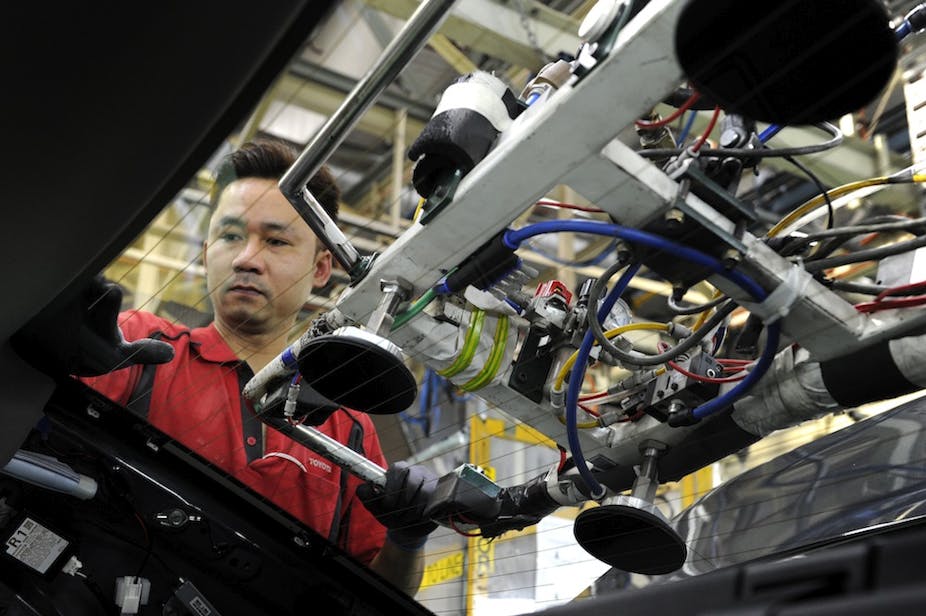As I’ve argued before and it’s generally accepted, the car industry is a critical part of Australia’s science and technology base. The sector spends A$600 million a year on R&D and another $800 million on buying inputs from the computing, engineering and consulting industry. So it’s a major producer and user of knowledge.
It also supports an incredibly diverse array of technologies, such as light metals, computerised machining, electronics, chip manufacture, plastics, chemicals, metallurgy, and a diverse range of robotics - technologies involved in assembling cars or making the components in cars.
All that will be lost with complete shutdown of the industry. There will be some of the auto component makers who are trying to diversify out, but a lot of those will fail, due to the sheer difficulty of innovating out of the auto sector. It really is a very difficult exercise to identify a new market and diversify into that market. It requires a lot of innovation and clever management.
Its affect on job creation
One of the positive aspects (in managing the transition away from a reliance on the car industry) is the long lead time on the three year shutdown. However, it’s important to note that is a maximum and it could well be - and appears to be happening at Ford - that the actual cessation of production could happen before that.
The critical aspect of labour redeployment is it very much depends on the quality and effectiveness of the measures put in place. What we know from many academic and government studies of redundancies in the Australian and global car industries is that it’s not a pretty picture.
As a rough rule of thumb, one third of workers will cease work altogether - they will retire, or go on the dole or the disability pension - or get a job at a lower level of work at lower wages and conditions, in either part-time or casual work. Another third will gain work in an equivalent or possibly higher level.
There are 45,000 people employed in the auto sector in what are reasonable quality jobs - mostly full time, with average weekly earnings and reasonable job tenure and a career path as well. What we know from our study for the Mckell Institute is the flow of new jobs into the economy over the last four decades has had mostly undesirable characteristics, such as the development of part-time casual jobs, contract work. Many automotive workers end up in retail, hospitality or aged care, cleaning, or security guard work.
About 80-90% of net employment growth - that is, hours worked - over the last four decades has been in industries with below-average productivity. This is one of the ironies. The Productivity Commission argues that getting rid of assistance to the motor vehicle sector will raise productivity across the economy, but misses the whole point. The reality is that it will almost certainly lower it.
Some sectors more deserving of assistance than others?
A really important thing to remember is the scale of the assistance to the sector. The Productivity Commission estimates the net value of assistance to the automotive industry is A$1.1 billion, calculated by the dollar equivalent of the tariff plus the direct budgetary assistance, or the cash transfers. But the actual value of output of the sector is around $21 billion. That is not a bad return of funds invested - the assistance is about 5% of the total output.
To put this in perspective: each year the ATO puts out a report which shows the value of the tax foregone for various industries. The 2013 report showed the superannuation industry received A$33 billion worth of tax concessions. This tax foregone was made up of the contributions on superannuation which taxed only taxed at 15%, and concessional tax on capital gains paid by super funds, which is also taxed at 15%. In addition there is the zero tax paid by those receiving a superannuation pension.
Then there is the $1.5 billion private health insurance rebate; or the $4 billion mining diesel fuel rebate. These are not classified by the Productivity Commission as industry assistance - while its definition would appear to include that, it seems to have made an arbitrary decision not to include a lot of these tax expenditures or define them as assistance.
What is going on here is almost certainly a quite conscious move to dismantle the whole post-war reconstruction view of the state and its active role in industry policy - it’s clearly a repudiation of that world view. In effect what we’re going to end up with in terms of our export base is regressing to a 19th century model of unprocessed agricultural and mineral resources.

